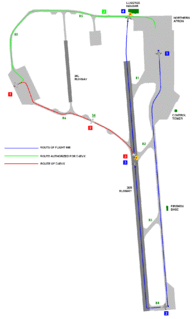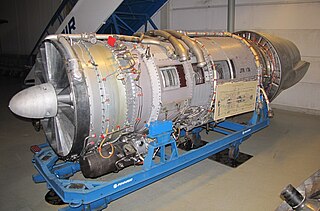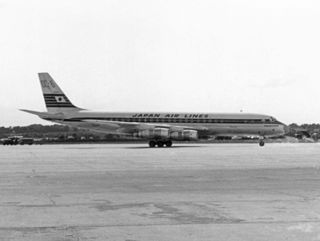
The Linate Airport disaster occurred in Italy in 2001 at Linate Airport in Milan on the morning of Monday, 8 October. Scandinavian Airlines Flight 686, a McDonnell Douglas MD-87 airliner carrying 110 people bound for Copenhagen, Denmark, collided on take-off with a Cessna Citation CJ2 business jet carrying four people bound for Paris, France. All 114 people on both aircraft were killed, as well as four people on the ground.

The McDonnell Douglas MD-80 is a series of single-aisle airliners developed by McDonnell Douglas from the earlier DC-9. Stretched, heavier, and with higher bypass Pratt & Whitney JT8D-200 engines, the DC-9 Series 80 was launched in October 1977. It made its first flight on October 18, 1979 and was certified on August 25, 1980. It was first delivered to launch customer Swissair on September 13, 1980, which introduced it into commercial service on October 10, 1980.

Delta Air Lines Flight 1141 was a scheduled domestic passenger flight between Dallas/Fort Worth, Texas and Salt Lake City, Utah. On August 31, 1988, the flight, using a Boeing 727-200 series aircraft, crashed during takeoff, resulting in 14 deaths and 76 injuries of the 108 people on board.

The Pratt & Whitney JT8D is a low-bypass turbofan engine introduced by Pratt & Whitney in February 1963 with the inaugural flight of the Boeing 727. It was a modification of the Pratt & Whitney J52 turbojet engine which powered the US Navy A-6 Intruder attack aircraft. Eight models comprise the JT8D standard engine family, covering the thrust range from 12,250 to 17,400 pounds-force and power 727, 737-100/200, and DC-9 aircraft. The Volvo RM8 is an afterburning version that was license-built in Sweden for the Saab 37 Viggen fighter. Pratt & Whitney also sells static versions for powerplant and ship propulsion as the FT8.
A compressor stall is a local disruption of the airflow in the compressor of a gas turbine or turbocharger. A stall that results in the complete disruption of the airflow through the compressor is referred to as a compressor surge. The severity of the phenomenon ranges from a momentary power drop barely registered by the engine instruments to a complete loss of compression in case of a surge, requiring adjustments in the fuel flow to recover normal operation.

The McDonnell Douglas DC-9 is a single-aisle airliner designed by the Douglas Aircraft Company. After introducing its heavy DC-8 in 1959, Douglas approved the smaller, all-new DC-9 for shorter flights on April 8, 1963. The DC-9-10 first flew on February 25, 1965 and gained its type certificate on November 23, to enter service with Delta Air Lines on December 8. With five seats across in economy, it had two rear-mounted Pratt & Whitney JT8D turbofans under a T-tail for a cleaner wing, a two-person flight deck and built-in airstairs.
A takeoff/go-around switch is a switch on the autothrottle of modern large aircraft, with two modes: takeoff (TO) and go-around (GA). The mode is dependent on the phase of flight; usually, on approach to land, the autopilot will be set to approach mode, therefore if the TO/GA switch is pressed it will activate the go-around mode of the autothrottle; conversely, when take-off is set on the autopilot, the switch activates take off mode of the autothrottle. On Boeing aircraft TO/GA modes are selected by a separate switch near the throttle levers, but on Airbus aircraft it is activated by pushing the thrust levers fully forward to the TO/GA detent.

Trans World Airlines (TWA) Flight 159 was a regularly scheduled passenger flight from New York City to Los Angeles, California, with a stopover in Cincinnati/Northern Kentucky International Airport, Kentucky, that crashed after an aborted takeoff from Cincinnati on 6 November 1967. The Boeing 707 attempted to abort takeoff when the copilot became concerned that the aircraft had collided with a disabled DC-9 on the runway. The aircraft overran the runway, struck an embankment and caught fire. One passenger died as a result of the accident.
Stefan G. Rasmussen is a former Danish pilot who captained the crash-landing SAS flight 751 on 27 December 1991. There were no fatalities in the crash, and Rasmussen received much recognition for his handling of the incident. He entered politics, and served in the Danish Folketing parliament from 1994 to 1996.

Spanair Flight 5022 (JK5022) was a scheduled domestic passenger flight from Barcelona–El Prat Airport to Gran Canaria Airport, Spain, via Madrid–Barajas Airport that crashed just after take-off from runway 36L at Madrid Airport at 14:24 CEST (12:24 UTC) on 20 August 2008. The aircraft was a McDonnell Douglas MD-82, registration EC-HFP. Of the 172 passengers and crew on board, 154 died and 18 survived.

Japan Airlines Flight 446 was a Japan Airlines flight from Sheremetyevo International Airport of Moscow, Russian SFSR, Soviet Union to Tokyo International Airport in Ōta, Tokyo, Japan.
Several aviation incidents and accidents have occurred in which the control surfaces of the aircraft became disabled, often due to failure of hydraulic systems or the flight control system. Other incidents have occurred where controls were not functioning correctly prior to take-off, either due to maintenance or pilot error, and controls can become inoperative from extreme weather conditions. Aircraft are not designed to be flown in such circumstances, however a small number of pilots have had some success in flying and landing aircraft with disabled controls.

On April 4, 1955, a United Airlines Douglas DC-6 named Mainliner Idaho crashed shortly after taking off from Long Island MacArthur Airport, in Ronkonkoma, Islip, New York, United States.

United Airlines Flight 2885 was a scheduled cargo flight from Cleveland to Los Angeles, with stopover in Detroit. On January 11, 1983, a DC-8 operating Flight 2885 crashed after take-off from Detroit, killing all 3 crew. The National Transportation Safety Board (NTSB) investigation determined that the cause for the crash was pilot error.

Air Algérie Flight 5017 was a scheduled international passenger flight from Ouagadougou, Burkina Faso, to Algiers, Algeria, which crashed near Gossi, Mali, on 24 July 2014. The McDonnell Douglas MD-83 twinjet with 110 passengers and 6 crew on board, operated by Swiftair for Air Algérie, disappeared from radar about fifty minutes after take-off. There were no survivors.

Delta Air Lines Flight 1288 was a regularly scheduled flight from Pensacola, Florida, to Atlanta, Georgia. On July 6, 1996, the aircraft serving the flight, a McDonnell Douglas MD-88, was on takeoff roll from Runway 17 at Pensacola when it experienced an uncontained, catastrophic turbine engine failure that caused debris from the front compressor hub of the number one left engine to penetrate the left aft fuselage. The impact left two passengers dead and two severely injured; the two dead were a mother and son. The pilot aborted takeoff and the airplane stopped on the runway. Three other passengers sustained minor injuries during the emergency evacuation. Most of the passengers were traveling on vacation.

Scandinavian Airlines System Flight 901, also known as SAS Flight 901, was a scheduled international flight operated by the Scandinavian Airlines System, that overran the runway at its destination at John F. Kennedy International Airport on February 28, 1984. The flight, operated by a McDonnell Douglas DC-10, originated at Stockholm Arlanda Airport, Sweden, before a stopover at Oslo Airport, Gardermoen, Norway. All 177 passengers and crew members on board survived, although 12 were injured. The cause was a runway overshoot due to the crew's failure to monitor their airspeed and overreliance on the aircraft's autothrottle.

Pan Am Flight 799 was an international cargo flight from Los Angeles International Airport to Cam Ranh Airport in South Vietnam that crashed on December 26, 1968 near Anchorage, Alaska. The aircraft involved was a Boeing 707-321C aircraft operated by Pan American World Airways. All three crew members died in the crash.

Ryan International Airlines Flight 590 was a cargo flight carrying mail for the United States Postal Service from Greater Buffalo International Airport (BUF) in Buffalo, New York, to Indianapolis International Airport (IND) in Indiana, with a stopover at Cleveland Hopkins International Airport (CLE) in Cleveland, Ohio. On February 17, 1991, the McDonnell Douglas DC-9-15RC operating the flight crashed on takeoff from Cleveland during icing conditions. Both pilots, the aircraft's only occupants, were killed. The National Transportation Safety Board (NTSB) determined that the causes of the crash were the flight crew failing to de-ice their aircraft, as well as the inexperience of the Federal Aviation Administration (FAA), McDonnell Douglas, and Ryan International Airlines with icing condition on DC-9-10 aircraft.















